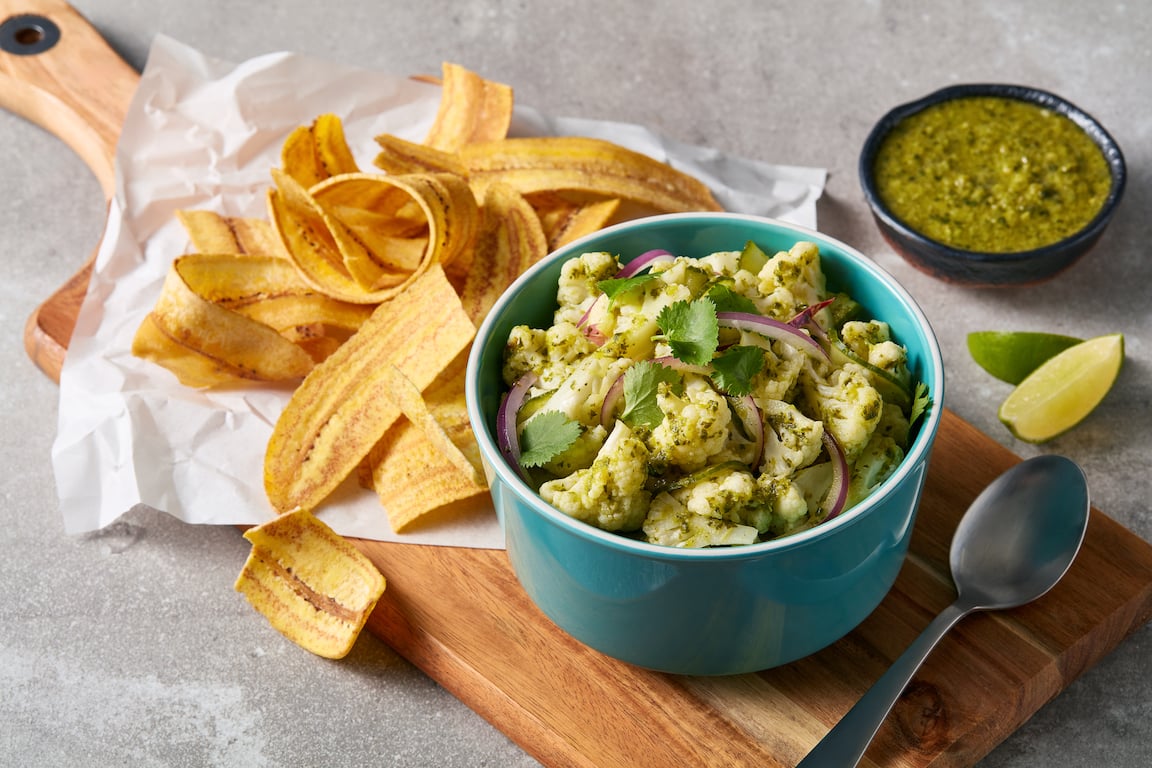


Christian Hallowell
Corporate Executive Chef | Senior Director of R&D
Bloomin’ Brands
Kitchen Collaborative is a recipe-development initiative formed by Summit F&B and Flavor & The Menu. To fuel flavor innovation, a group of talented chefs partnered with sponsor brands and commodity boards to create recipes that showcase the passion and potential of our industry.
“One unforgettable taste experience that will always stay with me is from my childhood on the black sand beaches of Montserrat in the Caribbean,” remembers Christian Hallowell, Corporate Executive Chef and Senior Director of R&D for Bloomin’ Brands. “Local boys brought freshly caught fish from their nets, and we cooked them right on the beach, over an open fire. After roasting the fish, we waded back into the waves, scraping off the charred skin and seasoning the tender flesh with a sprinkle of sea water. Standing in the warm Caribbean waters, eating freshly roasted fish out of our hands with friends, is a memory etched into my taste buds forever.”
Hallowell may not be in active pursuit of replicating this particular flavor remembrance, but it represents a host of ingrained experiences that drive so many chefs to the culinary arts, where they seek to reconstruct cherished flavor memories. Flavor drives the story, and Hallowell has created three dishes for Kitchen Collaborative that convey his passion and culinary vision: Latin-Roasted Pork Flatbreads with Rum-Soaked Pineapple and Black Garlic Butter; Vegan Cauliflower and Cucumber Aguachile; and Fontina, Apple and Walnut Piadina with Thyme.
Latin-Roasted Pork Flatbreads
Once introduced to the Latin-Style Citrus Chili Sauce from Custom Culinary, Hallowell gravitated toward its dynamic flavor profile—and its versatility. “It had great color and delivered layers of flavor,” he attests. “I was thinking of using it as both a marinade and a finishing sauce.” Practicality also played a role in his ideation. While the marinade would infuse meat with its rich flavors, the chef wanted to build a component that could be efficiently produced in high quantities and used with other dishes. The culinary offering, Latin-Roasted Pork Flatbreads with Rum-Soaked Pineapple and Black Garlic Butter, “is a light, appealing shareable, seamlessly blending taste and accessibility,” he says.
The dish is a flavor bomb of savory, sweet and tangy elements. “The pork is tender and flavorful, infused with the savory richness and subtle sweetness of the Custom Culinary sauce in the adobo marinade. The flatbread provides a neutral base to slather the earthy sweetness of the black garlic butter, complementing but not overpowering the other components,” says Hallowell. “The pineapple adds bright freshness, with its acidity and additional sweetness balancing the richness of the meat.”
“Latin-roasted” and “rum-soaked” menu descriptions certainly convey the promise of craveability. But “black garlic butter” is the mic drop. “While developing this recipe, I was refining another dish that featured black garlic butter, and I recognized the harmonious interplay of flavors that it could have with the pork,” he recounts. “I saw an opportunity to elevate the dish with an even greater infusion of global tastes and the trending popularity of black garlic.”
The marinade combines the Latin-Style Citrus Chili Sauce with orange juice, vinegar, peppercorns, cumin and allspice. Plus, it can be produced in large quantities for other uses. Hallowell ticks off the many options that would benefit from the Latin-inflected flavor boost of his marinade recipe: grilled chicken, seafood, vegetable skewers and tofu or tempeh. “It could also work as the sauce for stir-fried dishes, when added toward the end of cooking to coat everything in its flavorful goodness,” he notes. “Or, thin out the marinade with a bit of oil and vinegar for a dressing that can be drizzled over mixed greens, grilled vegetables or a grain-based salad.” The zesty blend of Latin flavors could also be incorporated into a classic Cuban pressed sandwich (“Tampa style, of course,” he clarifies) or any pork-based recipe.
Vegan Cauliflower and Cucumber Aguachile
Robust flavor is an imperative for vegan dishes, especially when restaurants seek to appeal to flexitarian patrons. But the resulting taste experience must be a careful balance between flavors that are assertive but not overpowering. Hallowell threads that needle with assurance, making the Jalapeño Pesto (S’chug) from SupHerb Farms a key player in a sauce that confidently lifts the flavors of this Vegan Cauliflower and Cucumber Aguachile.
The chef found the paste boasted a fresh flavor, great heat and a salty profile that integrated seamlessly into the aguachile. “I set out to craft a cold dish that retained the fresh, vibrant essence of the s’chug without subjecting it to heat, offering a vegan twist on a traditionally protein-centric dish,” he explains. “I selected cauliflower and cucumber for their subtle profiles, ensuring they could soak up the pesto’s essence without dilution.”
Each bite offers a vibrant blend of flavors, he says. “The pesto provides a bold kick of heat and freshness, complemented by the subtle nuttiness of the cauliflower and crunch of cucumber.” A touch of cilantro contributes a bright note. “This combination achieves a harmonious balance of spicy, savory and cooling sensations, making it an irresistibly craveable dish that won’t leave you longing for the traditional seafood component.”
Hallowell acknowledges the pros and cons of calling out a particular dish as vegan. Among the positives, he says, are transparency, inclusivity and a potentially savvy marketing opportunity. But he concedes that deep-set perceptions and biases are hard to overcome, especially when it comes to the belief that vegan dishes are less flavorful and satisfying than non-vegan items. “I also worry that labeling a dish as vegan might inadvertently pigeonhole it as suitable only for vegans, limiting its appeal to a broader audience,” he notes. That said, Hallowell finds the scales tipping toward the pros in the argument, especially when vegan citations make a point to emphasize flavor, quality and innovation.
Fontina, Apple and Walnut Piadina with Thyme
Hallowell understands that comfort food and culinary sophistication are not mutually exclusive goals, and his Fontina, Apple and Walnut Piadina successfully serves up both taste experiences “while highlighting Italian ingredients and techniques,” he explains. The dish is anchored on the piadina-style flatbread from Italy’s Emilia-Romagna region, a culinary touchstone for the Italian roots of the hero ingredient: BelGioioso® Shredded Fontina Cheese.
“Fontina’s creamy texture and excellent melting properties make it a perfect cheese for adding richness and depth to the dish,” says Hallowell, citing several key characteristics. “Fontina is known for its creamy and slightly elastic texture when melted. This quality allows it to coat the other ingredients evenly, binding them together for a cohesive, indulgent filling with a luxurious mouthfeel that ensures every bite is rich and satisfying.”
He also credits fontina’s mild, nutty flavor with subtle earthy notes. “This complements the sweetness of the apples and the richness of the walnuts without overpowering them,” he says. “The thyme adds aromatic depth, seamlessly intertwining with other ingredients for a fresh and sophisticated touch.”
Although the chef recommends experimenting with different apple varieties along the tart-sweet spectrum, his instinct for this dish was to specify Fuji apples, known for their sweet crispness. “It was a deliberate decision to balance the flavors. Not only do they provide a pleasant contrast to the savory richness of the fontina and earthy crunch of the walnuts, Fujis also help counterbalance any potential bitterness from the thyme,” Hallowell explains. “But varieties like Granny Smith, with their tartness, could offer a sharper contrast, while a Honeycrisp might provide a more subtle sweetness.”
Project Management: Summit F&B
Photography: Carlos Garcia // Food Styling: Peg Blackley











